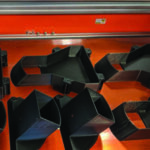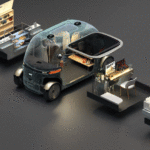Energy production systems are highly complex and varied, full of critical components that can handle extreme conditions. In other words, a perfect use case for 3D printing. Governments and private organizations around the world have been slowly but steadily testing 3D printed components in energy production systems, and this is a brief look at their progress.
Increasing the Efficiency of Legacy Energy Systems
In regards to conventional energy sources (fossil fuels), the US Department of Energy (DOE) has been funding advanced manufacturing research for several years. In 2018, 15 projects received a total of $8.8 million to test their technologies on fossil fuel systems. One project run by DNV GL will investigate the use of property gradients as microchannel heat exchangers for supercritical CO2 power cycle technology. United Technologies Research Center is creating computational methods of predicting the mechanical properties of additively manufactured nickel-based super-alloy parts for turbine engines. Siemens has been providing 3D printed metal replacement parts for industrial steam turbines for almost a year now, and they’ve demonstrated 3D printed turbine blades under full load. GE has also shipped over 9,000 3D printed gas turbine components.
In the nuclear arena, Russia’s state-owned nuclear power utility, Rosatom, started a company for the development of 3D printing technologies that has developed a Gen II printer for producing power components. Siemens installed a metallic impeller for a fire protection pump in the Krško nuclear power plant in Slovenia, demonstrating that older systems can be updated with modern production methods.
Augmenting Sustainable Energy Initiatives with Advanced Manufacturing Technologies
Solar power (photovoltaics) seems like the least likely energy format to apply 3D printing, but researchers are optimistic about the potential for 3D printing solar cells. MIT scientists believe 3D printed cells will be 20% more efficient and cost half as much as conventional cells. The Commonwealth Scientific and Industrial Research Organisation (CSIRO) in Australia 3D printed rolls of solar cells in the form of A3 sheets that can be applied to the surfaces of buildings to generate renewable power.
Wind energy systems, with their gigantic propellers that are shipped hundreds of miles, are perhaps the most obvious energy sources that could benefit from the integration of 3D printing. Fabricating wind turbines on site with 3D printers would not only save on freight costs but also eliminate the expensive and time-consuming mold process. The US DOE has partnered with public and private organizations to investigate doing just that.
Of course, renewable energy systems need somewhere to store their captured energy, namely batteries. Researchers from Manchester Metropolitan University have developed a 3D printer capable of fabricating graphene batteries, and a team at Harvard has created a method of 3D printing Lithium-ion batteries. Other researchers and engineers around the world have made other advances in 3D printed energy storage, such as the “redox flow” battery out of ETH Zurich.
Just as with manufacturing, 3D printing will increase the efficiency of energy production, storage, and distribution.
Featured image credit: Printed-Solar-Cells










